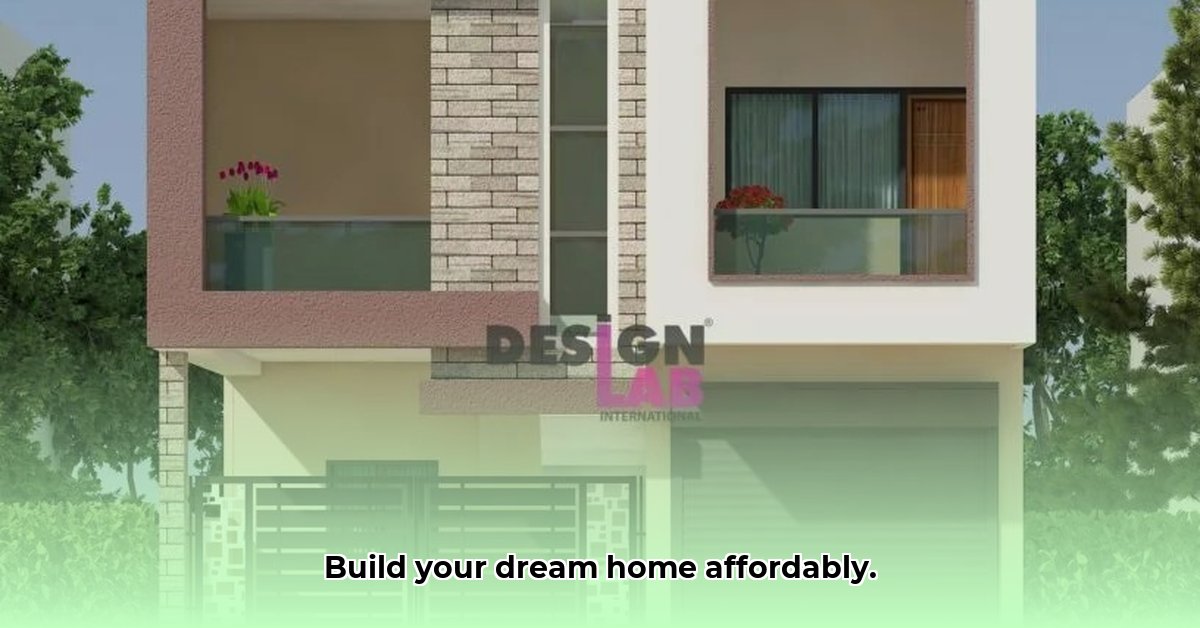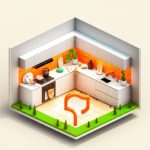Dreaming of a stunning, modern home that doesn’t break the bank? This comprehensive guide provides a roadmap to building your dream house affordably. Discover smart design choices, cost-saving strategies, and essential resources. Learn how smaller spaces can maximize savings, how to select the right materials, and where to find affordable plans and financing. For more simple modern design ideas, check out [this resource](https://www.wavesold.com/simple-modern-house-design). Let’s transform your dream modern home into an affordable reality!
The Low-Cost Modern House: Your Path to Affordable Living
Do you envision a sleek, modern home without the hefty price tag? You’re not alone! Building affordably is achievable with meticulous planning and a strategic approach. This guide empowers you to design and build your low-cost modern masterpiece. Imagine saving thousands by making informed decisions at every stage of the design process.
Understanding the Costs: A Realistic Budget Assessment
Before choosing paint colors, address the budget. Building a house involves significant expenses, so a clear picture upfront is vital to avoid surprises. Land prices, for example, can vary dramatically depending on location.
- Land: Location is paramount. Rural areas or smaller plots are generally cheaper than prime city locations. Consider your commute and lifestyle – are you willing to compromise on location for affordability? Investigate zoning regulations and potential restrictions on building before purchasing land.
- Materials: This is where significant savings are possible. Choose cost-effective and sustainable materials, such as reclaimed wood, locally sourced options, or innovative alternatives like bamboo. Research the long-term durability and maintenance costs of each material.
- Labor: Labor costs reflect the complexity of your design. A simple, straightforward design requires less labor than an intricate one. Factor in potential delays due to weather or material shortages, which can increase labor costs.
- Permits and Fees: Account for permits and inspections. Research local building codes early to prevent delays and expenses. Inquire about potential incentives or rebates for energy-efficient building practices.
Regional variations significantly impact costs. Prices for land, labor, and materials vary greatly depending on where you build. Obtain a local cost-to-build report tailored to your area for a realistic estimate. For example, foundation costs differ significantly in areas with rocky soil versus sandy soil.
Design Principles for Affordability: Smart Choices, Maximum Savings
Now, design your home! Smart design choices are critical to affordable building. How can strategic design choices translate into significant savings?
-
Embrace a Smaller Footprint: Think “efficient,” not “sprawling.” A smaller home means less material, less labor, and lower overall costs. Smart space planning can make a small home feel spacious and functional. Prioritize essential spaces and consider multi-functional rooms.
-
Simplicity is Key: Intricate architectural details increase construction complexity and cost. Opt for clean lines, simple shapes, and straightforward layouts. Modern design doesn’t need to be complicated to be stunning. Consider a rectangular footprint, which is more cost-effective than complex shapes.
-
Material Efficiency: Optimizing Material Use: Select cost-effective and sustainable materials:
- Reclaimed lumber: Gives your home character and is budget-friendly. Ensure it meets structural requirements.
- Locally sourced materials: Reduces transportation costs and supports local businesses. Research local suppliers and compare prices.
- Engineered wood: An affordable alternative to solid wood with comparable performance. Choose products with appropriate certifications.
- Concrete: A versatile and durable material that can be used for foundations, walls, and flooring. Consider polished concrete floors for a modern and low-maintenance option.
-
Prefabrication: Streamlining Construction: Prefabricated components built off-site can reduce construction time and labor costs. Building with pre-assembled pieces is faster and more efficient. Research different prefabrication methods, such as modular construction or panelized systems.
-
Modern Style Affordability: Many modern styles, like minimalist or Scandinavian design, lend themselves to affordability. Their emphasis on functionality and simplicity translates into cost savings without sacrificing style. Focus on maximizing natural light and creating open, airy spaces.
-
Passive Solar Design: Orient your home to maximize sunlight exposure in winter and minimize it in summer. This reduces heating and cooling costs. Consult with an expert on passive solar design principles.
Resources and Support: Building Your Team
Building a house requires a team effort. Find the right people to guide you.
- Cost-to-Build Reports: Online tools and local builders provide accurate cost estimates. Ensure reports factor in design elements and local costs. Obtain multiple reports from different sources.
- Affordable House Plans: Find affordable and well-designed house plans online. Customize plans to fit your needs and budget. Look for plans with detailed construction documents.
- Reputable Contractors: Research and vet contractors. Ask for references, check licensing, and compare bids. Don’t hesitate to ask questions! Verify their insurance coverage and bonding.
- Financing Options: Explore financing options, including government-backed loans and mortgages. Your financial institution provides guidance. Shop around for the best interest rates and terms.
- Architect or Designer: Consider hiring an architect or designer to help you with your design. They can help you create a plan that meets your needs and budget.
Navigating Regulations and Permits: Avoiding Costly Mistakes
Comply with local building codes and obtain necessary permits. Failing to do so can lead to delays, fines, and project rework. Research local regulations thoroughly. Contact your local building department for clarification.
Energy Efficiency: Long-Term Savings
Invest in energy-efficient features to reduce long-term operating costs:
- Insulation: Use high-quality insulation in walls, roofs, and floors. Consider spray foam insulation for superior performance.
- Windows and Doors: Choose energy-efficient windows and doors with low-E coatings. Look for Energy Star certified products.
- Appliances: Select Energy Star certified appliances to minimize energy consumption. Consider tankless water heaters for on-demand hot water.
- Solar Panels: Install solar panels to generate your own electricity. Take advantage of available tax credits and rebates.
Landscaping: Enhancing Curb Appeal and Value
Plan your landscaping to enhance curb appeal and increase property value:
- Native Plants: Use native plants that are adapted to your local climate. This reduces the need for watering and maintenance.
- Xeriscaping: Design your landscape to minimize water usage. Consider using gravel, rocks, and drought-tolerant plants.
- Trees: Plant trees to provide shade and reduce cooling costs. Choose trees that will not interfere with power lines or foundations.
Case Studies: Real-World Inspiration
Explore examples of successful low-cost modern homes for inspiration. Search online for case studies or visit open houses to see affordable modern living. Look for homes that incorporate sustainable design principles.
Conclusion: Making Your Dream Home a Reality
Building a low-cost modern house is achievable with thorough planning, smart design choices, and a team of reliable professionals. Create a beautiful, functional, and affordable home that reflects your style and needs. Patience and attention to detail are your allies on this exciting journey!
How to Compare Costs of Different Architectural Styles in Affordable Housing Design
Key Takeaways:
- Efficient floor plans minimize wasted space and reduce material and labor costs.
- Simple designs reduce construction complexity, speeding up the process and saving money.
- Sustainable and cost-effective materials contribute to long-term affordability.
- Prefabrication significantly lowers construction costs.
- Regional variations impact material and labor costs.
- Navigating regulations and permits is crucial for success.
- Energy efficiency reduces long-term operating costs.
Understanding the Cost Breakdown
Understand the key cost components in building an affordable home. Building a house requires materials, labor, and adherence to regulations, each with a price. What impacts the ingredient costs most?
- Land: Lot price varies with location. Suburban land is often cheaper than urban plots. Research zoning regulations and potential restrictions.
- Materials: Costs differ greatly depending on your choices. A simple ranch requires less material than a multi-level home. Compare costs of different architectural styles in affordable housing design here.
- Labor: Labor costs vary regionally and by design complexity. Obtain multiple bids from qualified contractors.
- Permits and Fees: These are set by local authorities and are a fixed cost. Research all applicable permits and fees.
Design Principles for Affordability
Design choices impact your budget. Is a complex design worth the labor costs?
-
Smaller, Smarter Floor Plans: Efficient space planning eliminates wasted space, reducing material and labor needs. A smaller house can feel larger than a poorly planned larger one. Prioritize essential spaces and consider multi-functional rooms.
-
Simple, Elegant Designs: Simple layouts reduce construction complexity and labor costs. A straightforward design translates directly into a budget-friendly project. Opt for clean lines and simple shapes.
-
Material Efficiency: Sustainable materials are often cost-effective in the long run. Consider materials abundant and affordable in your area. Research the long-term durability and maintenance costs of each material.
-
Prefabrication: A Cost-Effective Solution: Pre-fabricated components cut down on construction time and costs. They’re manufactured in a controlled environment, minimizing waste and errors. What is the estimated time saved during the prefabrication process for your chosen style? Research different prefabrication methods.
-
Architectural Styles and Their Cost Implications: Compare costs of different architectural
- Glass Tile Shower Ideas to Create a Stunning Bathroom Space - December 7, 2025
- Glass Wall Tile Ideas for Kitchens and Bathrooms - December 6, 2025
- Glass Tile Bathroom: Create a Beautiful, Easy-Clean Space - December 5, 2025










